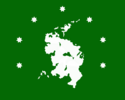Vallosian Economic Association
This article is a work-in-progress because it is incomplete and pending further input from an author. Note: The contents of this article are not considered canonical and may be inaccurate. Please comment on this article's talk page to share your input, comments and questions. |
The Vallosian Economic Association (VEA, Insuo Loa: iloiue ka'áása Ukatata hunaoi Kauiri, iUK) is a regional organization founded by the Treaty of Rangiura in 1977. As per its founding members, Takatta Loa and Almadaria, its goals are primarily economic, with stated policies of reducing trade barriers between member states to foster development of a regional economy, rather than a subsidiary of the global system. However, policymakers and representatives from its constituent and even observer members have often used the VEA as a forum for holding diplomatic talks regarding the Vallos subcontinent as a whole. The VEA, best described as a loose association with regional ambitions shared among its members, contrasts itself from UNESARP or the Levantine Union in its structure,
Vallosian Economic Association | |
|---|---|
|
Flag | |
 | |
| Location | Member states of the VEA (green) in Sarpedon (gray) |
| Government | Economic union |
| Establishment | |
• Treaty of Rangiura | 4 November 1977 |
A key factor that led to the establishment of the VEA was the liberalization, politically and economically, of the various Vallosian nations during the latter half of the 20th Century and beyond. International cooperation in light of extraregional influences became much more viable as a point of foreign policy of many, including the long-feuding governments of Takatta Loa and Almadaria.
Of moderate success, the VEA, though limited in its scope, has seen great development in the societies of and consolidation of financial capital within member states-- the gradual inclusion of Rumahoki into the Vallosian Economic Union has only strengthened these gains-- but some in opposition to increased globalization and neoliberal policy have argued that VEA and financial elite are the beneficiaries of the increased development, not the constituent nations and their citizens.
History
Background
The Vallosian Economic Association roots itself heavily in ideas of Pan-Vallos, an ideology that peaked in the mid-19th century that stressed the shared colonial burdens of the often marginalized Vallosian peoples, and how it can be undone or its peoples recompensed through unification or cooperation. The ideology did not have major pull in any Vallosian power-- the opposing interests of the Polynesian south and Tainean north largely precluded this-- but many in academic circles did respond positively to the idea of deeper Vallosian cooperation in light of emerging economic and political power blocs in Levantia and Mainland Sarpedon. Specifically, by the mid-twentieth century and through the Occidental Cold War, many Vallosian policymakers raised concerns over merely being subordinate to the emerging sophistication and development of Urcean and Caphirian power blocs.
In Almadarian academia, though far from official policy during the early 20th century century, Dependency Theory became in vogue for understanding the Almadarian republic's role and contributing factors to its own development. Pan-Vallos then was incorporated into this theory, suggesting that international cooperation could contest or roll back this perceived underdevelopment. In 1967, the discussion over Nainoa-Comonfort Bilateral Trade Agreement signed earlier that year prompted what would form the basis of what would later become the VEA; though met with much opposition in both Takatta Loa and Almadarian governments, eventually both legislatures approved to the formation of the Vallosian Economic Union.
Creation and early years
Enlargement
Modern history
Aims and achievements
Member States
| State | Population | GDP |
|---|---|---|
| Takatta Loa | 124,562,985 | $4,675,285,076,245 |
| Almadaria | 48,820,210 | $2,023,000,000 |
| Rumahoki | 52,328,520 | $2,474,000,000 |
Organizational structure
Primary Committee
The Primary Committee is the primarily legislative and executive body of the Vallosian Economic Association. As such, it is also its main decision-making organ; though the extent of which its decisions affects its members is highly dependent on the provisions lain out in the founding document, as well as the nominally neutral oversight organization of the Court of Justice (COJ-VEA). The Primary Committee is made up of the Main Commission, with one representative per member state, which acts as the head of the body. Much of the bulk of the Primary Committee is in its numerous Working Groups, which concern themselves with various trade and diplomatic topics.
Working Groups
- Working Group on Biological Sustainability, Development, and Trade
- Working Group on Mineral and Metals
- Working Group on Energy Concerns
- Working Group on Travel and Work Abroad
- Working Group on Financial Information Technology
- Working Group on Development of the Carrediaz/Karetia'asu
- Working Group on Anti-Corruption
- Working Group on Agriculture
- Working Group on Trade Relations
- Working Group on Cremation
Court of Justice of the Vallosian Economic Association
The Court of Justice is an advisory and regulatory body of the VEA. It is primarily made up of a panel of three representatives from each member nation in order to formulate and enforce VEA regulations within the association. A key tenet of the COJ-VEA is to prevent overreach of the organization, recognizing only the nation-state as a sovereign entity, yet granting the VEA limited sovereignty and legitimacy to enforce mutually agreed upon standards.
Court of Auditors
A subsection of the COJ-VEA is the Court of Auditors, primarily focused on enforcing the funding of the limited VEA bureaucracy, achieved by collecting an equal amount of dues from each member state.
